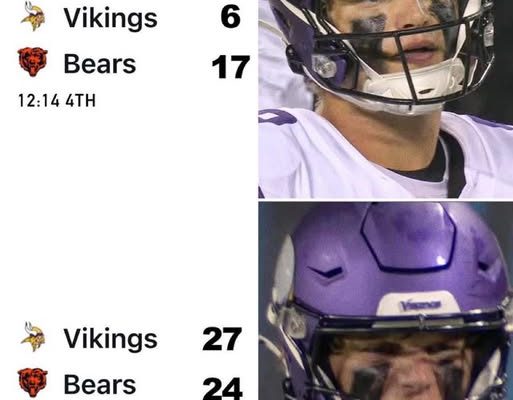Another prime-time game that flip flopped in the fourth quarter is exactly why fans keep tuning in week after week, no matter which teams are playing or what the stakes are. The unpredictability of sports, particularly football, is part of what makes it so intoxicating. You can watch three quarters of play, feel like you have a firm handle on who the winner will be, and then suddenly, in the final fifteen minutes, everything gets turned on its head. That’s the kind of drama that no scriptwriter could truly replicate, because the authenticity of athletes battling it out on the field adds a layer of tension that feels raw and real. It’s a reminder that momentum in sports is fragile, never permanent, and just one play—a turnover, a big sack, a long touchdown pass, or even a special teams mistake—can completely flip the outcome of a game. Fans across the country saw yet another example of this kind of chaos unfold under the lights, and the reactions are still pouring in.
Prime-time games carry an extra weight because they are played on the national stage. Everyone is watching—fans, rivals, casual viewers, analysts, and even players from other teams. The spotlight is bigger, the noise is louder, and the energy feels more intense. So when a fourth quarter delivers the kind of back-and-forth swings that leave people clutching their heads or screaming at their televisions, it instantly becomes memorable. The first three quarters of this game felt like a slow buildup, with one team holding an edge and seemingly dictating the flow. They were winning the battles in the trenches, dictating time of possession, and making the key third-down conversions. For much of the night, their opponent was forced to play catch-up, never quite looking sharp enough to mount a serious comeback. But as the game clock ticked closer to the fourth quarter, there was a noticeable shift. The team that had been in control began to stall. Penalties crept in, play calling got conservative, and suddenly the other side, the one that had been dormant, found a spark.
The fourth quarter in football is like no other stretch of time in sports. Everything gets magnified—the mistakes, the execution, the urgency. Coaches either cement their reputation as geniuses or get torn apart for questionable decisions. Quarterbacks either rise to the moment or collapse under the pressure. Defensive players either become heroes by forcing a turnover or goats if they blow a coverage. In this game, what started as a seemingly routine ending quickly turned into a rollercoaster. One side struck first, scoring a quick touchdown that reignited their hopes. The momentum immediately shifted. You could feel the energy in the stadium change, and even through a television screen, you could sense that the crowd knew they were about to witness something unforgettable. That’s the beauty of football—the collective gasp and roar when a team makes a play that shifts the narrative.
Of course, with momentum on their side, the trailing team began to play with more confidence. Their quarterback, who had been criticized earlier in the game for missing throws, suddenly found his rhythm. The wide receivers, who had been blanketed in coverage for most of the night, began making contested catches. The offensive line, once overwhelmed, started holding their ground just long enough to give plays time to develop. And then, in the blink of an eye, another touchdown. The lead was gone, and now the pressure flipped to the other sideline. For the team that had dominated three quarters, it was now a matter of survival. Their composure was tested in ways it hadn’t been all night. That’s what makes fourth-quarter flip flops so fascinating—how quickly the hunter becomes the hunted.
The defense of the team that lost control started to show cracks. A missed tackle here, a blown coverage there, and suddenly their once comfortable advantage looked flimsy. Every fan of that team could feel the nerves. You start counting the clock, wondering if there’s enough time to hold on, wondering if your team can make one more stop. That’s where coaching decisions become critical. Do you keep attacking offensively, or do you try to drain the clock? Do you blitz and risk giving up a big play, or do you sit back and try to prevent the deep ball? These are the split-second decisions that define games and legacies. And in this one, it seemed like no matter what decision was made, the other side had an answer.
What makes a flip-flop in the fourth quarter so exciting is that it rarely stops at just one shift. It’s not just one team storming back and then holding on. More often than not, it becomes a ping-pong of momentum. In this particular game, just when it looked like the comeback team had taken full control, the other side answered. A special teams return electrified the stadium. Then came a defensive stand that forced a punt, giving them life again. Suddenly, the team that had been unraveling found itself back in the driver’s seat. Fans on both sides were going through a range of emotions—elation, dread, hope, despair—sometimes all within the same series of plays. And with the clock winding down, every second became agonizing.
The final minutes were nothing short of chaos. Both teams traded haymakers, trying to deliver the decisive blow. Touchdowns were answered with touchdowns, field goals with field goals. It became less about who was the better team overall and more about who could execute under the crushing weight of pressure. That’s what prime-time games are supposed to deliver—a showcase of grit, determination, and resilience. By the time the final whistle blew, fans were left exhausted, drained, but also exhilarated. No one could have predicted the sequence of events that unfolded, and that’s the kind of unpredictability that cements games like this into memory.
One of the big talking points after the game was the play of the quarterbacks. Both had moments of brilliance and moments of frustration. In the fourth quarter, though, both showed why they belong in the spotlight. It wasn’t perfect—it rarely is—but the resilience to keep throwing, to keep taking hits, to keep believing in their ability to lead their team down the field, was remarkable. Fans will debate for days which quarterback had the better performance. Was it the one who engineered multiple scoring drives late? Or was it the one who, despite mistakes, delivered the final game-winning throw? These are the conversations that make football so engaging, because everyone sees the game differently, and everyone has an opinion worth sharing.
The defenses deserve credit too, even though the fourth quarter was dominated by offense. Without their earlier stops, turnovers, and key tackles, the game would have been over long before the final act. Football is never just about one unit—it’s about complementary play, and this game highlighted that perfectly. Special teams, often overlooked, also had a massive impact. A missed field goal, a big return, and a critical punt all played roles in shaping the drama. That’s the beauty of the sport—every phase matters, and every mistake or success is magnified under the lights.
Fans across the country took to social media immediately after the game, sharing their excitement, frustrations, and takes. Some declared it one of the best prime-time games of the season. Others lamented their team’s collapse or questioned coaching decisions. The debates will rage on all week, and that’s part of the fun. Football is about community, about shared experiences, and nights like this remind us why the sport is so deeply woven into the culture. You don’t just watch—you live it, you feel it, and you talk about it long after the final whistle.
Games like this also leave lasting impacts on a season. For the team that pulled off the comeback, it can be a turning point, a moment they point back to as the spark that propelled them forward. For the team that collapsed, it can be a gut punch, a loss that lingers and forces introspection. How they respond in the following weeks will be telling. Do they let the disappointment snowball, or do they rally and learn from it? That’s part of the narrative arc of a season, and fans will be closely watching.
This was more than just another football game—it was a reminder of why sports capture our imagination. The unpredictability, the drama, the highs and lows, the feeling that anything can happen, all came together in one unforgettable fourth quarter. If you watched it live, you’ll be telling people about it for weeks. If you missed it, the highlights will never quite capture the tension and emotion of the real thing. That’s why being there in the moment, whether in the stadium or in front of a screen, is so special.
I’d love to hear your thoughts on this one. Did you think the game was an instant classic, or do you see it as a case of sloppy play that made the ending feel wilder than it should have? Do you think the winning team showed resilience or just capitalized on mistakes? And for the fans of the losing side, what do you think went wrong—was it coaching, execution, or just bad luck? Comment below and let’s talk about it, because games like this deserve to be dissected from every angle.



